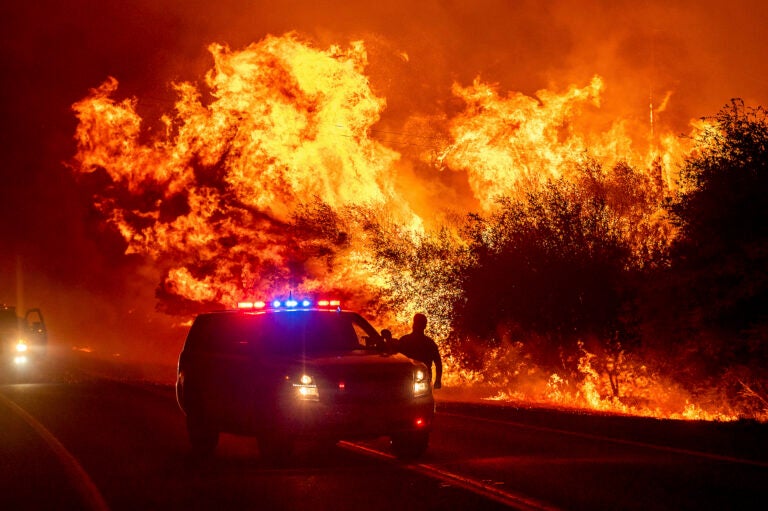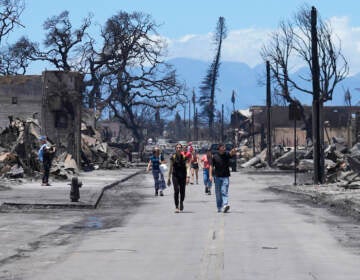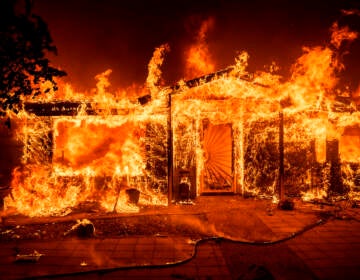Explosive wildfires across California stoked by fierce winds
Wildfires raged unchecked across parts of the western U.S. on Wednesday amid gusty and dry conditions, but forecasters said some weather relief was in sight.

Flames lick above vehicles on Highway 162 as the Bear Fire burns in Oroville, Calif., on Wednesday, Sept. 9, 2020. (AP Photo/Noah Berger)
Wildfires raged unchecked across parts of the western U.S. on Wednesday amid gusty and dry conditions, but forecasters said some weather relief was in sight that could help firefighters overwhelmed by the blazes.
In California, winds stoked unprecedented numbers of fires that have forced rescues and evacuations. In Washington, more acres burned in a single day than firefighters usually see all year. Fires also forced people to flee in Oregon and Idaho.
A temperature plunge of as much as 60 degrees, caused by a dramatic intrusion of polar air, helped slow wildfires that spread in Colorado and Montana.
“The significantly colder airmass is helping reduce critical fire conditions across the West, however most of West coastline and adjacent counties have Red Flag warnings in effect for part of today,” the National Weather Service said. A warning is issued when conditions combine to produce an increased risk of fire danger.
Diminishing winds were possible by Thursday, “bringing some relief to the ongoing fires and fire weather threat,” forecasters said.
A massive cloud of smoke covered much of California on Wednesday, dimming the sun to an eerie orange glow over San Francisco.
About 125 miles to the northeast, winds fanned a huge fire in the Sierra Nevada foothills and forced authorities to order early morning evacuations and warn other residents to be ready to leave.
The area is not far from the town of Paradise, where 85 people were killed by a fire two years ago, and Oroville Dam, where failing spillways forced a massive evacuation in 2017.
On Tuesday, flames overtook 14 firefighters who had to delploy last-resort emergency shelters and destroyed a fire station in Los Padres National Forest on California’s central coast. They suffered burns and smoke inhalation, and three were flown to a hospital in Fresno, where one was in critical condition, the U.S. Forest Service said.
Helicopters have been used in recent days to rescue hundreds of people stranded in the burning Sierra National Forest, where a fire has destroyed 365 buildings, including at least 45 homes. About 5,000 buildings were threatened, fire officials said.
Flames threatened the foothill community of Auberry between Shaver Lake and Fresno.
In Southern California, fires burned in the mountains of Los Angeles, San Bernardino and San Diego counties, with the potential for the region’s notorious Santa Ana winds to push flames out of wilderness and into communities.
People in a half-dozen foothill communities east of Los Angeles were being told to stay alert because of a fire in the Angeles National Forest.
“The combination of gusty winds, very dry air, and dry vegetation will create critical fire danger,” the National Weather Service warned.
The U.S. Forest Service on Monday closed all eight national forests in the southern half of the state and shutter campgrounds statewide.
More than 14,000 firefighters are battling fires in California Two of the three largest blazes in state history are burning in the San Francisco Bay Area, though they are largely contained after burning for three weeks.
The state has set a record with nearly 2.3 million acres burned this year and the worst part of the wildfire season is only beginning.
“It’s extraordinary, the challenge that we’ve faced so far this season,” Gov. Gavin Newsom said.
The threat of winds tearing down power lines or hurling debris into them and sparking a wildfire prompted Pacific Gas & Electric, the state’s largest utility, to shut off power to 172,000 customers in Northern California. More outages were expected Wednesday, with power not expected to be completely restored until Wednesday night.
The Southern California Edison utility warned that about 55,000 customer accounts may lose power while San Diego Gas & Electric said 16,700 customers were at risk of a preemptive outage.
In the Sierra National Forest east of Fresno, dozens of campers and hikers were stranded at the Vermilion Valley Resort after the only road in — a narrow route snaking along a steep cliff — was closed Sunday because of the so-called Creek Fire.
“This is emblematic of how fast that fire was moving, plus the physical geography of that environment with one road in and one road out,” said Char Miller, a professor of environmental analysis at Pomona College, said of the helicopter rescues. “Unless you wanted an absolute human disaster, you had to move fast.”
Numerous studies in recent years have linked bigger wildfires to global warming. “The frequency of extreme wild fire weather has doubled in California over the past four decades, with the main driver being the effect of rising temperature on dry fuels, meaning that the fuel loads are now frequently at record or near-record levels when ignition occurs and when strong winds blow,” Stanford University climate scientist Noah Diffenbaugh said in an email.
Associated Press writers Christopher Weber, Frank Baker and John Antczak in Los Angeles, Olga Rodriguez and Juliet Williams in San Francisco, Adam Beam in Sacramento and Seth Borenstein in Washington contributed to this report.
WHYY is your source for fact-based, in-depth journalism and information. As a nonprofit organization, we rely on financial support from readers like you. Please give today.





